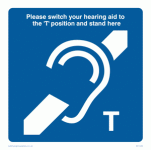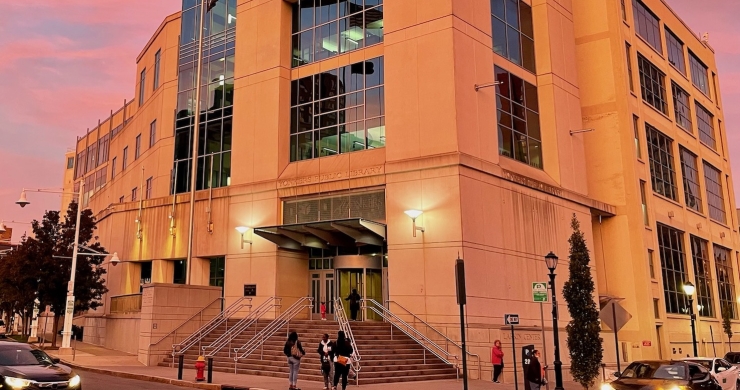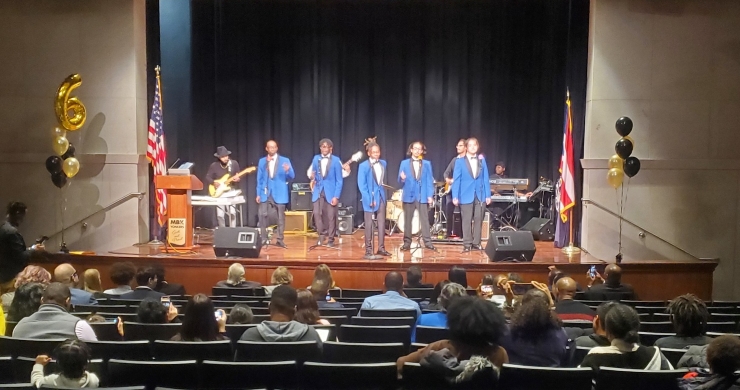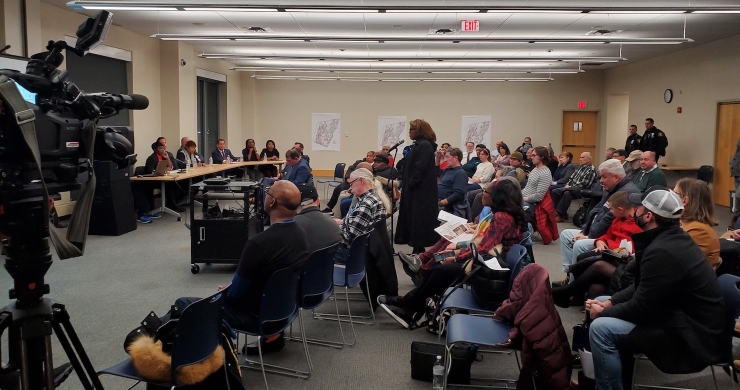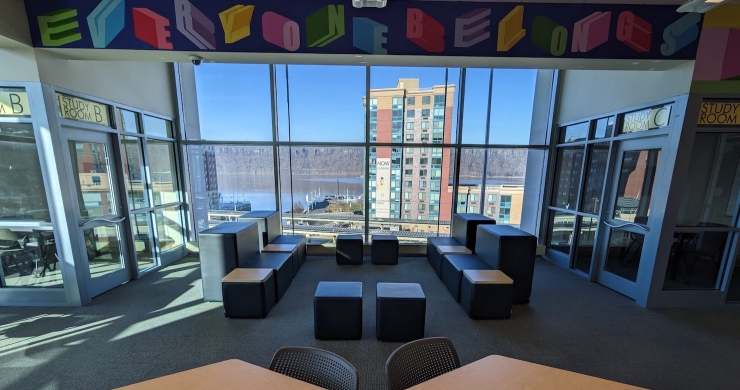About the Riverfront Library
Riverfront Library, which opened in 2002, is YPL’s newest library and located in the heart of Yonkers’ downtown riverfront area. Sharing a building with the Central Office of Yonkers Public Schools and other City of Yonkers departments at One Larkin Center, Riverfront is a four story, 70,000 square foot library with commanding views of the Hudson River and Palisades.
Riverfront Library houses nearly 150,000 books and DVDs that cover all subjects for all audiences. It also provides plentiful seating, Wifi, and electrical outlets for students, researchers, and remote workers. It also offers more than a dozen meeting rooms for meetings, programs, resource fairs and other community events.
Riverfront Library also serves the Yonkers community through a wide array of programs and services, including: family friendly events, early childhood literacy programs, technology training, career readiness workshops, adult education classes, and English language learning services.
- Riverfront Auditorium: a 450 seat auditorium that hosts important civic events, musical performances and film screenings.
- Tech Central: Located on the third floor, Tech Central is a learning lab, makerspace and media lab that fosters digital literacy and production through technology training, STEM classes, and informal learning opportunities.
- Riverfront Art Gallery: Located on the fourth floor of the Riverfront Library, the gallery exhibits contemporary, local, and internationally acclaimed artwork. The mission of the gallery is to present a diverse and balanced schedule of exhibits of high caliber, progressive artwork and related programs not frequently seen in Yonkers and surrounding communities.
- The Cove: is a recently-redesigned play space located on the second floor Children's Room at Riverfront Library.
- Local History Room: Located on the third floor, the Local History Room contains books on Yonkers and Westchester history, maps, dissertations, high school yearbooks, city directories, and a clippings file. Please contact the Riverfront Reference Department with questions regarding local history. Dial 914-375-7966, or email localhistory@ypl.org for more information, or to make a research appointment. The Local History Room is not accessible to the public.
- Literacy Solutions Office: Located on the second floor, Literacy Solutions New York (LSNY) offers English for Speakers of Other Languages (ESOL) Virtual and In-Person Classes, case management services, and citizenship classes and services for New Americans.
Directions to Riverfront Library
BY CAR
From the North:
• Saw Mill River Parkway South to Exit 5, Yonkers Ave.
• At the exit, turn right onto Yonkers Ave., which merges into Nepperhan Ave. & becomes Prospect St.
• Take Prospect to the end, Buena Vista Ave.
• Turn right onto Buena Vista Ave.
• Turn right onto Hudson St.
• Turn left into Buena Vista Garage.
From the East:
• Cross County Parkway West to Exit 2, Saw Mill River Parkway North.
• Exit immediately at Exit 5, Yonkers Ave.
• Turn right onto Yonkers Ave., which merges into Nepperhan Ave. and becomes Prospect St.
• Take Prospect to the end, Buena Vista Ave.
• Turn right onto Buena Vista Ave.
• Turn right onto Hudson St.
• Turn left into Buena Vista Garage.
From the South (From Manhattan):
• Henry Hudson Parkway North, which becomes Saw Mill River Parkway North, to Exit 5, Yonkers Ave.
• Turn right onto Yonkers Ave., which merges into Nepperhan Ave. and becomes Prospect St.
• Take Prospect to the end, Buena Vista Ave.
• Turn right onto Buena Vista Ave.
• Turn right onto Hudson St.
• Turn left into Buena Vista Garage.
From the South (Bronx, Queens, Long Island):
• Hutchinson River Parkway, the Bronx River Parkway, or the Major Deegan Expressway North (I-87) to the Cross County Parkway West.
• Cross County Parkway West to Exit 2, Saw Mill River Parkway North.
• Exit immediately at Exit 5, Yonkers Ave.
• Turn right onto Yonkers Ave., which merges into Nepperhan Ave and becomes Prospect St.
• Take Prospect to the end, Buena Vista Ave.
• Turn right onto Buena Vista Ave.
• Turn right onto Hudson St.
• Turn left into Buena Vista Garage.
BY BUS
Bee-Line bus 1C, 1T, 1W, 2, 3, 4, 5, 30 or 78 to Getty Square.
Ask directions to Yonkers Railroad Station (a 3 block walk). Library is across the street.
Bee-Line bus 6, 7, 9, or 32 to Yonkers Railroad Station. Library is across the street.
BxM3 to Getty Square. Ask directions to Yonkers Railroad Station (a 3 block walk). Library is across the street.
BY SUBWAY
#1 train to 242nd St. Bee-Line bus 1C, 1T, 1W, 2 or 3 to Getty Square. Ask directions to Yonkers Railroad Station (a 3 block walk). Library is across the street.
#2 train to Nereid Ave. Bee-Line bus 25 to Getty Square. Ask directions to Yonkers Railroad Station (a 3 block walk). Library is across the street.
#4 train to Woodlawn. Bee-Line bus 4 to Getty Square. Ask directions to Yonkers Railroad Station (a 3 block walk). Library is across the street.
BY TRAIN
Metro-North Hudson Line to Yonkers Railroad Station. Library is across the street.
Riverfront Library Phone Numbers
Branch Administration: 914-375-7947
Circulation: 914-375-7940
Information: 914-375-7965
Children’s Dept: 914-337-1500, x427
Reference Dept: 914-375-7966
Adult Services Dept: 914-375-7968
Riverfront Library Floor Plan
History of the Riverfront Library
“A magnificent transformation of an abandoned industrial building.”
So spoke the Governor of New York at the Larkin Center dedication ceremonies on September 18, 2002.
After 20 years in a modified department store, the main branch of the Yonkers Public Library was about to occupy its new home, sharing the 200,000 square foot Larkin Center building with the administrative offices of the Yonkers Board of Education.
Completely renovated for its new role, the building had been constructed 76 years earlier, one of the last buildings to be built here belonging to the Otis Elevator works.
The story begins before the Civil War …
In the early 1850s Elisha Graves Otis, a native of Halifax, Vermont, was working for a bedstead manufacturing business that had recently relocated to Yonkers from New Jersey. Needing to transport various materials from one floor of the building to another, he designed a “hoister” to make the task easier.
Hoisters had been constructed before, but this one was unique. At a crucial point in the mechanism, Otis had ingeniously added a steel spring. Should the hoisting cable fray and break, the platform holding the goods would, after slight descent, be supported by the spring rather than fall all the way to the ground. In effect, Elisha Otis had invented the safety elevator.
On September 20, 1853, at the foot of Vark Street, Elisha opened his elevator works. Word had spread of his invention, and he’d learned that there was some demand for it.
Elisha Otis is said to have publicized his product in 1854 by a dramatic public demonstration at the Crystal Palace Exhibition in New York City. With Otis himself standing on the platform, the platform was hoisted to a dangerous height, and then the hoisting cable was deliberately cut. The horrified crowd watched as the platform began to fall — and then came safely to a stop.
Elisha Otis died in April 1861. His sons Charles and Norton continued their father’s business, eventually incorporating it as Otis Brothers and Company. (It was not until 1898 that the business was renamed the Otis Elevator Company.)
Also In 1861, the Otis plant relocated several blocks to the north. The first building of what would become the formidable Otis complex was constructed at the corner of Wells and Woodworth Avenues.
The early elevators were operated by steam or hydraulic power. The electric elevator was perfected in the late 1880s with the introduction of an electric motor that was invented by Yonkers resident Rudolf Eickemeyer. And it was to manufacture the company’s motors in a building dedicated to that purpose that in 1926 Otis constructed the four-story structure which was later transformed into Larkin Center.
(Mayor Thomas F. Larkin died in office unexpectedly in 1928. The Common Council honored him shortly after his death by naming for him the plaza, stretching westward from Warburton Avenue almost to River Street, which at the time was under construction as a civic improvement. Both Larkin Plaza and the adjacent Larkin Park were demolished in the early 21st century in order to “daylight” the Saw Mill River.)
The Otis company came to establish plants all over the industrialized world, and the Yonkers works became one of the city’s largest employers.
On two occasions in the later half of the 20th Century, the City of Yonkers feared the loss of a thousand-plus local jobs should the Otis works move out. Concessions were made to the company, including the privatizing and subsequent transfer to the Otis company of city streets.
The second such concession, in the early 1970s, seemed to augur a lasting success. On November 16, 1974, ground was broken for an Otis expansion project. (The ceremonies that day even included a re-enactment of the Crystal Palace demonstration.) “May the Yonkers-Otis partnership, by which we all benefit,” the Herald Statesman editorialized, “grow and prosper throughout the next century as well.”
Alas, it was not to be.
In 1976, Otis was merged with the United Technologies Corporation, becoming a wholly owned subsidiary of UTC. The Yonkers plant was shuttered in August 1983.
In 1984 the Port Authority of New York and New Jersey purchased the site of the old Otis complex from UTC for the purpose of turning it into an industrial park.
About 15 years later, around the turn of the century, the property was acquired by the City of Yonkers.
The Yonkers Industrial Development Agency subsequently purchased the Larkin Center parcels from the City for about $800,000.
The IDA then enlisted the assistance of the National Development Council to oversee the design and construction of the Larkin Center. (The National Development Council is described on its website as a private, nonprofit organization that offers “community partners” development assistance and “debt and equity for” for public facilities projects.)
The architectural firm of Highland Associates, having won a “competition by invitation,” was engaged to design Larkin Center by renovating the old Otis building. “Besides renovations,” as Highland notes on its website, https://www.highlandassociates.com/yonkers-public-library, “an 80,000 square foot addition was added to the entire front face of the building.” (The website notes that in 2004 the building won the Westchester County Office Building of the Year Award.)
Baltimore’s Whiting-Turner Contracting company was hired to effect the needed structural transformation, gutting and refacing the old building while retaining its frame and the floors.
And so, after three failures to do so — two in the 1970s and one in the 1990s — the City of Yonkers had by summer 2002 succeeded in building a new home for the main branch of the Yonkers Public Library.
The dignitaries who delivered remarks on the occasion of the September 2002 dedication and ribbon-cutting ceremonies included the Governor of New York, George Pataki, the Mayor and the Deputy Mayor of Yonkers, John Spencer and Philip Amicone, the President of the Yonkers Board of Education, Robert Ferrito, the Superintendent of the Yonkers Public Schools, Joseph Farmer, the President of the Board of Trustees of the Yonkers Public Library, Dr. William Sheerin, and Library Director Stephen Force.
Located diagonally across the street from Metro North’s main Yonkers train station, the Larkin Center has — as Stephen Force once noted — a “classic, monumental, civic-building look.” The large, blue-tinted windows, strikingly set off by the bright white of the building’s cement facade, are of practical value as well as aesthetic. For they shield the library’s patrons in the main reading areas from the glare of the sun as it sets — slowly or swiftly, depending on the season — behind the Palisades on the west side of the Hudson River.
Equipped from opening day with an extensive collection of audio and video materials on the first floor, a spacious children’s room on the second floor; a reference department, reading area, and local history room on the third floor; and a large circulating collection of both fiction and nonfiction books on the fourth floor, the library has also provided patrons from the start with multiple study rooms, meeting rooms, and publicly accessible computers. In later years, an art gallery was installed on the fourth floor and a state-of-the-art Tech Center on the third floor.
At once forward-looking and retrospective was Dr. Sheerin’s remark on September 18, 2002:
“As Yonkers enters a new era, moving from the industrial age to the information age, it is indeed appropriate that a building which once was a factory will now be used as a high-tech center for learning and community development.”
Create Your Family Tree / Crea tu árbol de familia
Create Your Family Tree / Crea tu árbol de familia
Get together to talk about your genealogical research. Learn how to access thousands of genealogical records using the Library's online resources and databases such as HeritageQuest, Family Search and Ancestry!
Cuentos in the Cove: Bilingual Storytime
Cuentos in the Cove: Bilingual Storytime
Join us for a session of stories and songs in Spanish and English! Children must be accompanied by a caregiver. No registration required.
More Information
Children under 8
No person shall leave young children (ages eight and under) unattended anywhere on library premises. Parents or guardians are expected to look after their children while visiting the library with them.
Parents must stay
Parents/Guardians must stay - this is not a drop-off program.
Chalk It Up!
The Cove has a chalkboard wall, and we want you to help us decorate it!
More Information
Children under 8
No person shall leave young children (ages eight and under) unattended anywhere on library premises. Parents or guardians are expected to look after their children while visiting the library with them.
Parents must stay
Parents/Guardians must stay - this is not a drop-off program.
Classic Movie Monday – A Matter of Life and Death (1946)
Classic Movie Monday – A Matter of Life and Death (1946)
Classic Movie Mondays
Enjoy matinees featuring classic Hollywood films — and iconic Hollywood stars — from the 1930s, '40s, '50s, and '60s.
This week: A World War II-era fantasy-romance, A Matter of Life and Death (1946), from British filmmaking greats Michael Powell and Emeric Pressburger, starring David Niven and Kim Hunter.
More Information
No outside food & drink
No outside food or drink is permitted in the Library.
Kid Tech Gaming
Come play games in Tech Central! We have more than just our Switch available to play during this extra hour of gaming fun. Enjoy games on our laptops, VR headsets, PS5, and more!
More Information
Children under 8
No person shall leave young children (ages eight and under) unattended anywhere on library premises. Parents or guardians are expected to look after their children while visiting the library with them.
No outside food & drink
No outside food or drink is permitted in the Library.
Homework Helper @ Riverfront
Get homework help from a qualified tutor - no registration required!
This free program is available to students in grades K–7 and runs during the school year while school is in session.
Schedule:
More Information
Acknowledgement: Foundation for the Yonkers Public Library

This program is made possible through generous support from the Foundation for the Yonkers Public Library (FYPL).
Intro to Microsoft Word
Learn the basics of using Microsoft Word, including creating, editing and saving documents.
Storytime with Mr. Ralph
Come hear stories old and new! Let your imagination carry you away to distant times and places!
More Information
Parents must stay
Parents/Guardians must stay - this is not a drop-off program.
National Bird Day
Learn about the different species of birds. Color pictures of your favorite birds!
Services at Riverfront Library

3D Printing
3D printing is a free service offered at the library. A Yonkers library card is required. You can design your own 3D object OR download a 3D file.

- Library-by-Mail is a service provided by Yonkers Public Library for library materials to be mailed to people who are homebound.
